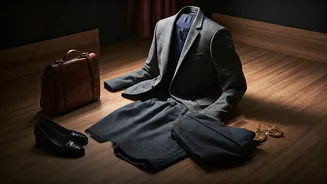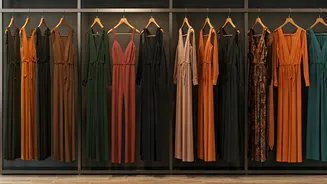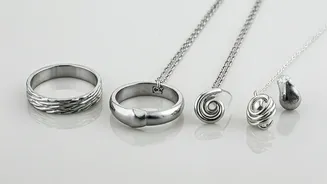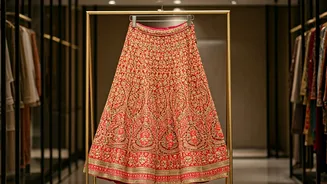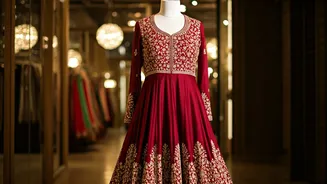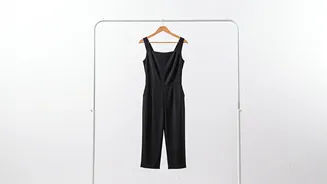Fit is Fundamental
One of the most frequent fashion missteps involves poor fit. Clothing that doesn't align with your body shape can completely ruin an otherwise great outfit.
Overly tight garments restrict movement and can be unflattering, highlighting areas you might prefer to conceal. Conversely, oversized clothing can drown your frame, making you appear less polished. The right fit is about enhancing your silhouette, not hiding it. Knowing your measurements and choosing clothes that accommodate your body type is vital. Consider seeking professional tailoring, or explore brands with size-inclusive options. When shopping online, carefully review size charts and customer reviews to ensure an accurate fit. Try different sizes and cuts to find what works best. Investing in well-fitting basics provides a solid foundation for any wardrobe. This will ensure you always look put together, irrespective of the other elements of your look.
Color Coordination Chaos
Another frequent fashion blunder lies in the misuse of color. Certain color combinations clash, creating an unpleasant visual effect that detracts from the entire look. The key to avoiding these pitfalls is understanding color theory, specifically the color wheel. Complementary colors, found opposite each other on the wheel (like blue and orange), can create bold pairings, while analogous colors (next to each other, like blue and green) provide a more harmonious look. Neutral colors such as black, white, gray, and beige provide a versatile base and are simple to combine with other shades. Be careful when wearing too many patterns or bright colors simultaneously, as this can overwhelm the eye. Start with a neutral base and add pops of color through accessories or a single statement piece. If you're unsure about color combinations, keep it simple and safe. Stick to a monochromatic palette (variations of the same color) or a neutral base with one or two contrasting colors. Remember, confidence is your best accessory, but understanding color coordination will make you look more polished.
Accessory Overload
Accessories can elevate a look, but they can easily become a fashion hazard if overdone. Too many accessories can clutter an outfit, making it appear busy and distracting from the overall style. Remember that less is often more. Avoid wearing excessive jewelry, multiple scarves, or too many belts simultaneously. Choose one or two key accessories to complement your attire. These might include a statement necklace, stylish earrings, a chic handbag, or a distinctive belt. The goal is to enhance, not overwhelm. Consider the event and your clothing's style when selecting accessories. For a simple outfit, add a bold necklace to serve as a focal point. For a more elaborate ensemble, opt for more subtle accessories to avoid competing with your clothes. Consider proportion and scale when selecting accessories; smaller pieces are generally better for delicate outfits, while larger ones can anchor bold ensembles. Assess your final appearance in a mirror before heading out, ensuring the accessories enhance and complement your attire rather than detracting from it.
Ignoring the Basics
Basic wardrobe staples form the backbone of a stylish wardrobe. Overlooking the importance of quality basics is a prevalent fashion mistake. These essential pieces include a well-fitting white shirt, a classic pair of jeans, a versatile black dress, and a simple blazer. Quality basics ensure your wardrobe is not only functional but also adaptable to various events and styles. High-quality basics provide a strong foundation for experimenting with trends or building a minimalist wardrobe. They offer timeless appeal and can withstand seasonal changes. The right basics allow you to mix and match items effortlessly, creating numerous outfits from a few key pieces. Prioritizing basics helps to build a more streamlined and practical wardrobe. Investing in quality, versatile items ensures long-term wear and reduces the need for frequent replacements. Embrace the timeless appeal of well-chosen basics to create a polished and enduring style that will always stand the test of time.
Wearing Ill-Fitting Shoes
Footwear plays a crucial role in any outfit, yet it's often a source of fashion blunders. Ill-fitting shoes can not only ruin the aesthetics of your attire but also cause discomfort and damage to your feet. Wearing shoes that are too tight, too loose, or the wrong size can impact your posture, gait, and overall look. Properly fitted footwear should provide adequate support and cushioning. Ensure there's enough space in the toe box and that the shoes do not pinch or rub against your feet. Choosing the correct shoe size is essential, and it is also advisable to get your feet measured periodically, as their size can change over time. The wrong shoes can severely detract from an outfit. Consider the type of event and your clothing when selecting shoes. Comfortable and appropriate footwear is vital for any outfit, whether it’s a pair of boots, flats, or heels. Remember that shoes should complement the attire, and more importantly, they should fit and feel comfortable.
